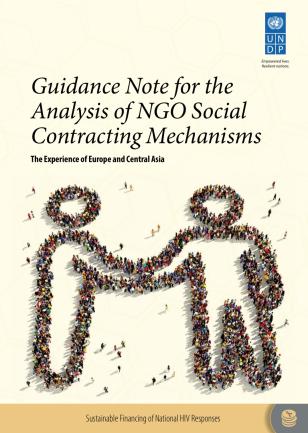Guidance for NGO social contracting mechanisms
Guidance for NGO social contracting mechanisms
May 27, 2019
International funding of the HIV responses in Eastern Europe and Central Asia has experienced significant constraints over the last couple of years. The Global Fund to Fight AIDS, Tuberculosis and Malaria (Global Fund) has revisited eligibility criteria for countries to access funding, which has also affected a number of countries. Many of these countries are still heavily dependent on external funding for their national HIV and TB responses. The new eligibility criteria puts higher demands on domestic financing sources and some countries will fully cease to be eligible for further Global Fund support.
Increasing and improving access to prevention and treatment is crucial for countries to meet their international public health obligations, and to achieve the Sustainable Development Goals (SDGs) especially SDG 3 – Good health and well-being for all. Given these shifts, sustainable financing of national HIV responses is a priority concern and UNDP together with partners is providing countries with policy, strategy and technical support and has developed several flagship publications to guide these processes.
Guidance note for the analysis of NGO social contracting mechanisms
Non-governmental organizations (NGOs) play a very important role in HIV responses. In many countries, they are the only or the leading service providers for key populations – men who have sex with men, people who inject drugs, sex workers, and for other vulnerable groups. NGOs also provide substantial support to people living with HIV.
In countries that are transitioning from foreign aid to domestic financing, sustainability of the HIV response requires more than just a sufficient HIV budget allocation. A legal framework, effective mechanisms and transparent procedures that allow governments to contract NGOs for provision of HIV- related services to everyone who needs them are key.
This Guidance Note aims to help international organizations, government, NGOs and other stakeholders to develop factsheets and to use the facts and recommended actions for setting up or improving NGO social contracting mechanisms. A step-by-step guide is provided, allowing not only easy use, but also a standardization of the factsheets.
Modelling an Optimised Investment Approach
These report for Uzbekistan and Tajikistan use a right-based approach to develop short-, mid- and long-term investment strategies for effective national HIV responses looking at how 3 scenarios for development of the HIV epidemic. The reports were developed in close collaboration with partners including National AIDS Centers, UNAIDS, the World Bank and the Global Fund to Fight AIDS, Tuberculosis and Malaria.
Towards Domestic Financing of National HIV Responses
The reports for Croatia and Serbia present an overview of the implementation of the GF grants and transition processes to national financing mechanisms. They focus on distilling experiences and lessons learned around the key enabling factors for successful transition processes to more domestic financing sources and mixes. The reports were prepared in collaboration with the Institutes of Public Health of Croatia and Serbia as key partners.
Legal and regulatory frameworks for ARV medicines and treatment
The reports focus on the analysis of critical factors affecting the affordability and accessibility of antiretroviral (ARV) medicines on the level of treatment guidelines, regulatory frameworks related to registration, licensing, and other forms of marketing authorization, procurement and supply management, as well as IP rights status which predetermines the opportunity to access generic equivalents. They provide decision makers and other stakeholders on the country and regional levels with practical background information and an analytical review which will assist to optimize strategies for the selection and provision of affordable, quality ARVs at the quantities required to scale-up ART to universal coverage, with particular focus on key populations at higher risk of HIV.

 Locations
Locations




